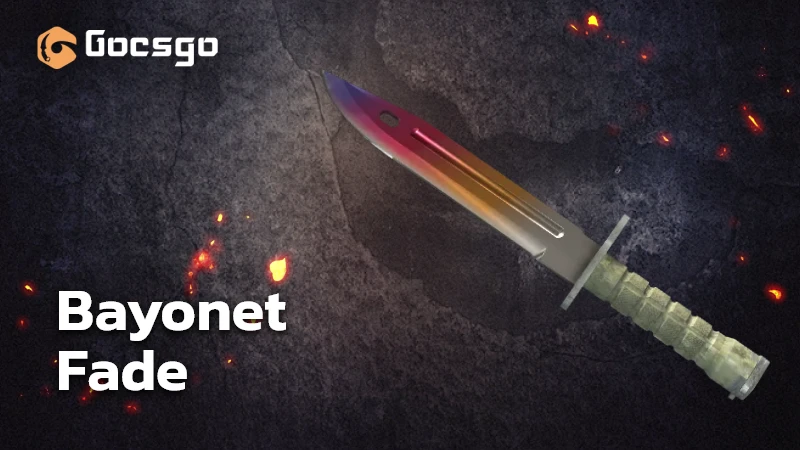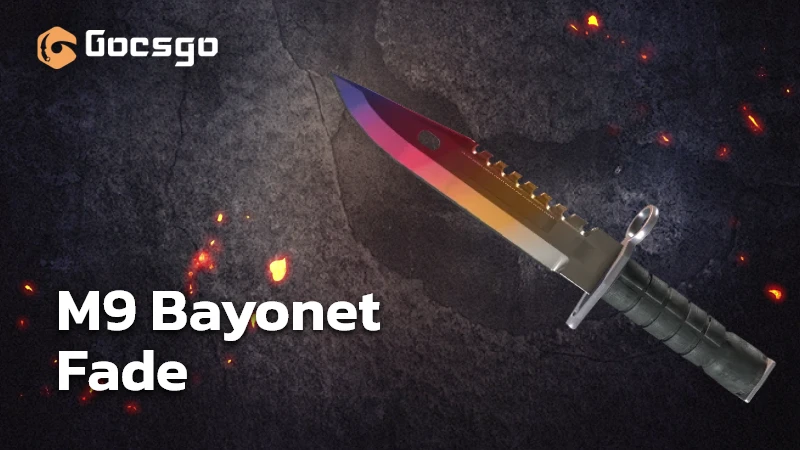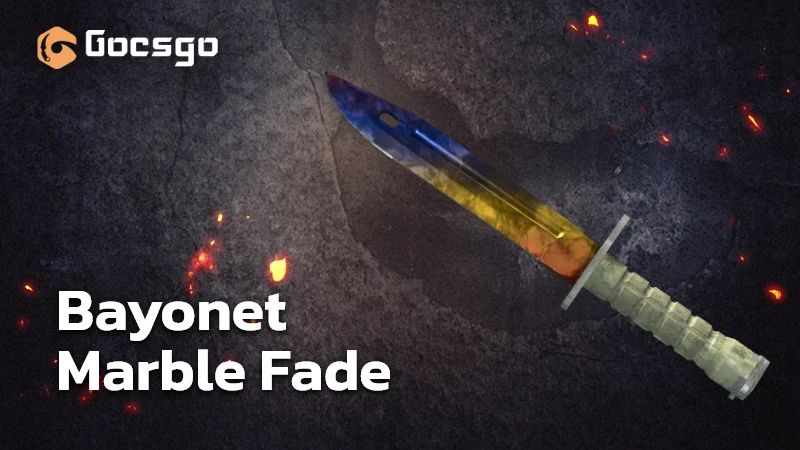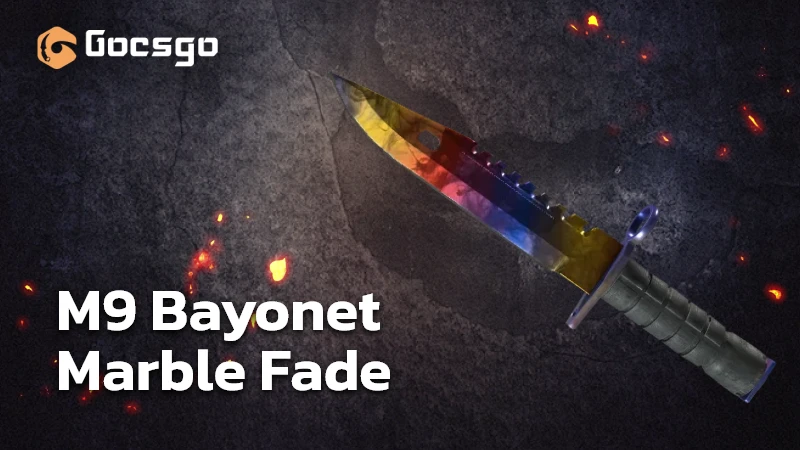There’s something about the Bayonet Fade that just doesn’t go out of style. In CS2, even with the upgraded lighting and wear rendering, this skin shines just as bright—literally and figuratively. I’ve owned and inspected more Fades than I can count, and every time I see a near-full Fade Bayonet in a match, I still pause to admire it. But here’s the truth: not every Bayonet Fade is created equal.
If you’re just starting to explore the Fade family—or you’re looking to upgrade your current knife—this guide breaks down exactly how to spot high-tier Bayonet Fades, what patterns to look for, how float values affect pricing, and where the M9 Bayonet Fade and Marble Fade stand in comparison. I’ll even walk you through how to avoid overpriced or low-tier knives that look good on paper but don’t deliver in-game.
Understanding Bayonet Fade Tiers and Patterns
What Is a Bayonet Fade?
The Bayonet Fade is a classic CS2 knife skin with a color gradient that transitions from gold, through pink, to deep purple. The best ones—called Full Fades—cover the blade almost entirely with these vivid colors. Others, known as Reverse or 80% Fades, leave part of the blade silver or dull, reducing both the aesthetic and the value.
How Patterns Determine Fade Tier
Each Bayonet Fade has a pattern index, and that index determines how much of the blade shows the Fade gradient. A pattern index like 417 or 444 results in a higher fade percentage (close to 100%), while something like pattern 168 might only show an 85% fade.
What is Bayonet Fade?
Bayonet Fade is a very classic blade skin in CS2. Its blade color starts from bright gold, gradually transitions to pink, and finally turns into dark purple. The whole gradient process is very smooth and looks very textured. The top-level style is called “full gradient”, and almost the entire knife is covered with these bright colors, which is very eye-catching. Those versions called “reverse gradient” or “80% gradient” will leave a part of the silver or gray area, which is not only inferior in appearance, but also has a relatively low market value.
How is the gradient level determined?
Each Bayonet Fade has a pattern number (Pattern Index), which determines the proportion of gradient color coverage on the blade. Pattern numbers like 417 or 444 are often high-end styles close to 100% gradient, which look rich and beautiful. A number like 168 may only cover about 85% of the gradient area, leaving obvious silver or dull areas on the blade.
Here’s a rough breakdown of tiers:
Tier 1 (Full Fade): 99%–100% fade coverage. Pattern IDs like 444, 412, 421.
Tier 2: 95%–98%. Still beautiful, but slightly less vibrant on the tip.
Tier 3: 90% or lower. More silver at the tip, less color pop.
If you’re buying purely for visuals or future resale, aim for a Tier 1 Full Fade. These consistently hold their value and get the most attention in-game.
How to Check Pattern and Fade Percent
Before buying, plug the knife into a third-party inspection tool like or use the in-game inspect with pattern metadata. Look closely at the tip of the blade—a Full Fade should have zero silver showing and a saturated purple tone at the very end.
How Float Values Affect Bayonet Fade Value
Float value is a key part of any CS2 skin’s price, but for the Bayonet Fade, it affects both looks and price. All Bayonet Fades fall under the Factory New (0.00–0.07) and Minimal Wear (0.07–0.15) categories, but the most sought-after ones sit under 0.03.
The Sweet Spot: Factory New, Low Float
0.00–0.02: Ultra-low float, premium pricing. Blade looks glossy and pristine.
0.02–0.04: Still great, visually clean and easier to find.
0.04–0.07: Budget-tier FN options. Minor scratches but often still vibrant.
0.07–0.15: MW Bayonet Fades exist, but they lose shine and drop in resale value.
If I’m spending serious money on a Bayonet Fade, I always go for Factory New under 0.03. Not just for the looks—but because collectors and traders pay a premium for that float when it’s paired with a Tier 1 pattern.
Bayonet Fade vs. M9 Bayonet Fade vs. Marble Fade
Let’s talk comparisons. I’ve owned and traded both Bayonet Fade and M9 Bayonet Fade, and here’s what separates them—and how they stack up to the Marble Fade, another fan favorite.
Bayonet Fade
There is a reason why the Bayonet Fade has always been popular. Its blade has neat lines and the gradient color is clean and neat, which is very suitable for players who like the “simple + high-end” style.

M9 Bayonet Fade
The M9 Bayonet has a wider blade, so the Fade pattern looks even more dramatic. A Full Fade on an M9 is visually striking and commands a higher market price. But here’s the catch: it’s also harder to find a true 100% Fade on an M9.
Pricing (as of 2025):
M9 Bayonet Full Fade FN: $1,500–$2,200+
M9 Bayonet 90% Fade: $1,100–$1,400
M9 Full Fades are a collector’s dream. They’re rare and don’t stay on the market long.

Marble Fade (Bayonet and M9 Variants)
The Marble Fade is a different animal entirely. It has a swirl pattern instead of a gradient, with blue, red, and yellow tones. Unlike Fades, Marble Fade tiers are defined by color balance and rare combos like Fire & Ice or Ice & Ice.
Marble Fade price range (2025):
Bayonet Marble Fade (Fire & Ice Tier 1): $1,300–$2,000

M9 Bayonet Marble Fade (Fire & Ice): $2,200–$3,000+

In comparison, Marble Fade has more patterns and richer color combinations, but it may be a bit dazzling for new players. If you like a stable appearance and classic gradient effects, it is recommended to choose Fade. If you have a sufficient budget and want to pursue rare patterns, then go for Fire & Ice marble gradient, which is rare and has a stronger collection value.
Where and How to Buy or Trade for a High-Tier Fade
Whether you’re buying from a case opening site, a third-party marketplace, or trading through Discord, these are the checks I always follow.
Step-by-Step: How to Pick a High-Tier Bayonet Fade
If you want to buy a truly outstanding Bayonet Fade, it is not enough to just look at the price. You must understand the following details clearly:
1. Try to choose a float value below 0.03
The lower the float, the less wear the knife will have and the brighter the appearance. The ideal range is 0.01–0.02, the lower the better, especially for full fade, low float will make the color more saturated.
2. Check the pattern number (Pattern ID)
Use the float checker or the in-game inspection function to check the knife’s Pattern ID. Some of the top fade pattern numbers are 444, 421, 412, etc. These patterns usually bring a more complete color transition.
3. Confirm the Fade percentage
Want a full fade? Then you need to see if there is any silver on the tip of the knife. If there is almost no silver on the tip of the knife, it is a top-level Full Fade. But don’t just look at the number or float, it is most reliable to judge by eye.
4. Compare prices: Buff.163, Skinport, Steam Market
Don’t buy impulsively, check the prices on these platforms first. Buff.163 in particular usually reflects the real market price and is suitable for reference.
5. Ask for pictures! Ask for links!
Always remember to ask the seller to send screenshots or inspect links. Even if the pattern number and float are good, if the screenshot looks gray, then the knife is not worth that much.
Where to Buy or Open Bayonet Fades
CS2 Case Openings:
Bayonet Fades are in cases like Revolver,Operation Bravo Case, CS:GO Weapon Case and so on. Knife odds are low, but if you love unboxing, try sites like Gocsgo with my code JOINNOW15 for free bonuses and chances to score Fade knives at a discount.
Steam Community Market:
Usually overpriced and slow, but safe if you’re patient.
Conclusion
If you have a certain pursuit of CS2 knife collection, the Bayonet Fade is still one of the cleanest and safest choices. It has a classic appearance, high value retention, and a large group of collectors. Although it is not as fancy or complicated as the Marble Fade, this is its charm – a classic that never goes out of style.
There are three standards for the perfect Fade in my mind: a full gradient pattern (Full Fade), a float value below 0.02, and a blade that shines in any light. If you can find such a knife at a suitable price, don’t hesitate to buy it directly. Not only will it not go out of style, but as the market supply tightens, it may even appreciate in the future..
FAQs
1. Which pattern numbers are suitable for Bayonet Fade?
444, 412, 421 are the best, almost all gradient. When buying, be careful not to expose the silver on the tip of the knife.
2. How much will Bayonet Fade cost in 2025?
Full gradient is about 800-1200 US dollars, ordinary pattern or high wear is about 600 US dollars or less. Compare prices before buying.
3. Can CS2 still open Bayonet Fade?
Yes, but the probability is very low (about 0.26%).

